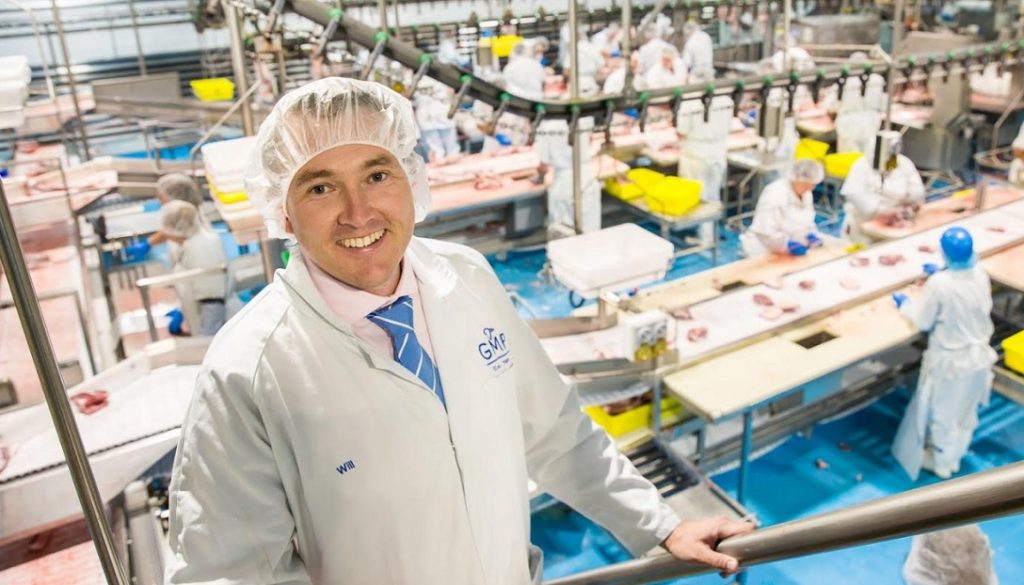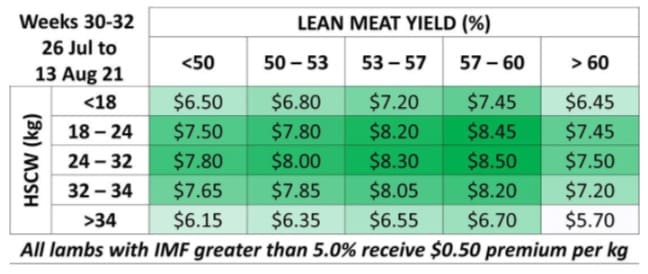
Gundagai Meat Processors CEO Will Barton.
A LAMB producer has achieved a 43c/kg carcase weight premium for a high intramuscular fat consignment in the first results from the Gundagai Meat Processors world-first IMF grid offering.
In mid-May this year, GMP offered its world-first lamb grid paying producers on lean meat yield, weight and intramuscular fat, with feedback on animal health at an individual carcase level.
Gundagai Lamb’s Late Season Lamb Grid offered producers an average price of $7.50 per kilogram on a hot standard carcase weight/lean meat yield basis for May, June and July delivery. the company is now booking lambs for late July/ mid August delivery under a new price grid.
On the grid, an intramuscular fat or marbling bonus of 50 cents a kilogram was paid for lambs with an IMF of 5 percent or higher. It was aimed at Meat Standards Australia-accredited consignments of 150 lambs or more, of all breeds, although Merino, Dohne and SAMM lambs by application only.
In the first results, from mainly old lamb consignments, GMP chief executive officer Will Barton said that in the best mob of lambs sent to GMP on the grid, 85 percent of the consignment had an IMF higher than 5 percent.
“Which means that producers got the bonus 85pc of the time, which over the consignment amounted to 43c/kg carcase weight.
On average, 30pc of most consignments were over 5pc in IMF and the worst producer achieved this for 3pc of their lambs.”

The average producer received the bonus for 30pc of lambs consigned, which equated to an additional 15c/kg on the grid pricing overall. Mr Barton is now looking forward to seeing what happens to IMF performance in Spring, from suckers or new season lambs.
He said GMP’s first IMF grid had allowed for a heavier lamb, and a new grid has been released for late July to mid-August matching prices to fat scores (GR measurements), lean meat yield categories and carcase weight.

“The higher IMF was associated, not surprisingly, with heavier fatter lambs.”
Mr Barton said the factors that contributed to turning off a high IMF lamb included nutrition, genetics rather than breed, and age, and he doesn’t expect that any specific nutritional regimen or breed “is the king” for producing high IMF.
“I think it will always be a combination of producers using their smarts and all of those things in combination and for some it might be one of them more than others.
“The ultimate I guess is to turn something off grass with a high IMF.”
The high IMF consignment came off a grazing crop, but some lambs off feedlots had also performed well. The top five consignments to date did not all have a common breed or finishing backgrounds, Mr Barton said.
“What it demonstrated to us, and it’s what the science has been telling us for some time, is that there are lots of ways to achieve IMF.
Producers need information linking fat score to lean meat yield

He said the new simplified grid for producers reflected more information on which fat scores lined up with which lean meat yield categories. The above table shows how DEXA lean meat yields are lining up with fat scores from the old fat palpation system. Mr Barton said it is important to understand that these are not exact matches, but rather the most common correlations being seen.
“We’ve provided that table (above) in the grid documentation to say this is the most likely fat score for each of these lean meat yield categories.
“It’s a not perfect correlation, there is a lot of overlap, but people needed that to be able to make decisions,” he said.
“What we’ve realised is that the person that consigned us lambs with 3pc of (+5pc) IMF is unlikely to consign to us again, but the person with 85pc is unlikely to go anywhere else, because they got 43c/kg extra.
“So what it demonstrates to us is that if people are willing to give it a go in terms of trying out and getting the feedback to understand where they sit, they might find that they’ve got a home here that gives them absolutely the best value to reward them for their IMF,” Mr Barton said.
“They might find that they’ve got the opportunity to improve if they are in the middle of the road, and keep coming here, or they might find that they are on the wrong side of it and they have no intention of changing that.
“That’s what it is about for us, to attract those to us who believe what we believe about the future of it, but what a great result for those people with high IMF, that all of a sudden they are getting really strong pricing for their article,” he said.
“We can build a brand around that.”
Mr Barton said producers will want to know if and how they can repeat good IMF results. GMP is also interested in that and he said after 12 months and after surveying the top producers, the business will be in a position to give some insights.
“We are just not far enough into it.”
Mr Barton is looking forward to seeing what impact seasonality has on IMF in consignments in the next 12 months.

It’s terrific to see this happening. I have a number of clients selecting sires with high IMF, low shear force and carcase yield. They would be very keen to start getting on board.
This is game-changing science for producers. Australian Sheep Breeding Values for IMF and ShearF5 now become key parts of a producer’s selection criteria. The ability to add $10/carcase to your sale sheep is a turning point for the meat side of the sheep production, especially Merinos. We know there is a not insignificant proportion of Merinos that has better eating quality (IMF & ShearF5) than crossbreds. Merino producers will be able to sell wether lambs into the supermarket and export lamb markets.
If you use genetics and a breeding program based on ASBVs and genomics, the truth is in the data, your eye is for the data, not how good s(he) looks. Those days are gone; science is the basis of your selection criteria.
The technology was developed through extensive consultation and collaboration with leading sheep producers, and funded substantially by the private sector with minimally funds provided at a key point with a small contribution from Meat & Livestock Australia. That is the way research should be done; supporting the private sector at key development points to the benefit of producers and not trying to develop technology in competition with the private sector when there is no market failure. Take note Australian Wool innovation.
Very well done to the team at GMP and their producer supporters, “I dips me lid”.
Robert Ingram
Director AWGA
Robert, this is not as simple as it seems on the surface. Gundagai is using intramuscular fat as a marketing tool. We have to keep asking the question: is IMF good for the consumer and the sheep? If it is good for these two things, it will be good for Gundagai and us.
IMF is a saturated fat – omega 6s – bad for humans, according to Dr Graham Gardner, from WA. In my opinion, IMF maybe a more fluid fat, more easily recovered and put back by the sheep. Selvedge fat could be harder to re-absorb.
There are two reasons we need to put genetic fat into Merinos — taste in the meat and stored energy. Stored energy for lamb survival, worm resistance, wool tensile strength, adult resilience in tough times, fertility, etc, etc. However, fat bites into wool production.
There are three basic areas where fat is laid down — selvedge fat, inside fat (kidney area etc) and IMF. Taste comes from fat. IMF could be bad for you and selvedge fat maybe better for humans. Both forms of fat put taste into meat when cooked. The inside fat has nothing to do with taste. At the end of the day, it is just a good stored energy source.
I don’t think we want to breed Wagyu sheep with extremes of IMF. In cattle, there could be a correlation between IMF and butterfat in milk. Better lambs if it is the same in sheep. So the big question is, we definitely need some fat, but do we need IMF?
I disagree with your comments on, “those days are gone.” If you don’t look at the sheep you run the risk of buying the wrong shape, bad feet, ASBV’s that are not accurate. There are no ASBVs for selecting rams that will breed better females, yet there are wonderful physical markers for selecting rams to do just that. How do you deal with dermatitis, yellow wool or sheep that will get fly-blown with out looking at the sheep? Maybe genomics will cover some of the problems.